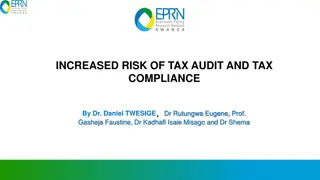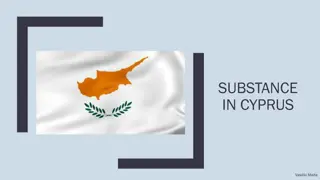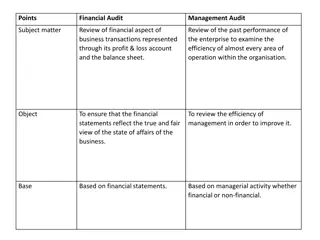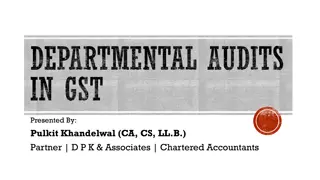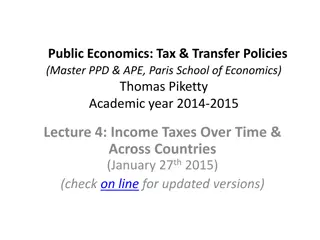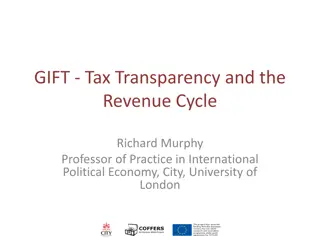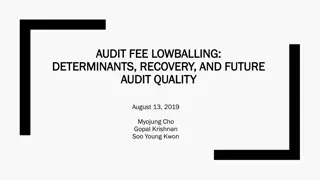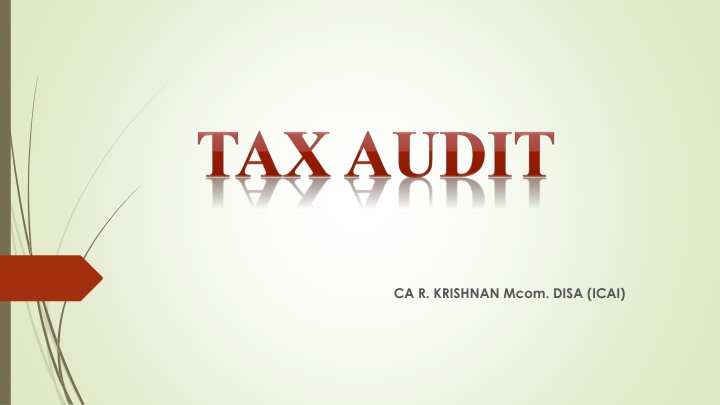
Tax Audit and Form 3CD for Effective Compliance
Learn about the importance of tax audit, Form 3CD, and the responsibilities involved in ensuring accurate tax compliance. Discover key aspects such as scope, objectives, and significance in income tax filing.
Download Presentation

Please find below an Image/Link to download the presentation.
The content on the website is provided AS IS for your information and personal use only. It may not be sold, licensed, or shared on other websites without obtaining consent from the author. If you encounter any issues during the download, it is possible that the publisher has removed the file from their server.
You are allowed to download the files provided on this website for personal or commercial use, subject to the condition that they are used lawfully. All files are the property of their respective owners.
The content on the website is provided AS IS for your information and personal use only. It may not be sold, licensed, or shared on other websites without obtaining consent from the author.
E N D
Presentation Transcript
INTRODUCTION Tax audit is a systematic and independent examination of books of accounts to ascertain a correct picture of tax liability and to provide disclosures as per tax laws involves examination/review of accounts of any business/ profession carried out by taxpayers from an income tax viewpoint. leads to easier income computation for filing ROI.
44AB Applicable to Sl no Persons Condition 1 Carrying Business and NOT opting sec 44AD Carrying Business and opting sec 44AD Carrying Profession and NOT opting sec 44ADA Carrying Profession and opting sec 44ADA Total sales or turnover exceeds Rs.1 crore Total sales or turnover exceeds Rs.2 crores Gross Receipts exceeds Rs.50 lakhs Claims income below 50% of Gross Receipts. Further his income exceeds non-taxable threshold Falls under section 44AD(4) and income exceeds non-taxable threshold. Claims income below the deemed income 2 3 4 5 Carrying Business and opting sec 44AD 6 Carrying Business and opting sec 44AE, 44BB, 44BBB
Scope and Effect of Sec. 44AB Refer CBDT Circular No 387 dtd 6th July, 1987. Objective as explained in para 17.2 Ensure the books of account and other records are properly maintained. They faithfully reflect the income of the tax payer and ensure correct claim of deductions. Checking fraudulent practices. Facilitate the administration of tax laws. Saving the time of the assessing officers from attending to checks on such accounts, for attending to more important investigational aspects of a case.
OBJECTIVES OF DISCUSSION To understand the purposes of Form 3CD To learn nuances of the clauses To understand audit risk To effectively carry out attestation To document adequately To disclose standard notes, limitations and stands To know inter links between clauses To be aware of important stands taken by Courts To understand the objective of the tax department
UDIN being made mandatory from 1st April , 2019 for TAs One Time Relaxation Extension of time limit of UDIN generation from 15 days to 30 days Certificate / Report / Document signed between 20th August, 2019 to 31st Dec, 2019.
Form No. 3CD Challenge for Taxpayers & Tax Auditors! Mandated large reporting requirements. Require the tax auditor to step in the shoes of AO and express judgements. extensive efforts to collect the details for reporting purposes. The amendments put a substantial onus on the tax auditor. Responsibility of Tax payers and Tax Auditors Taxpayers Tax Auditor Setting forth the prescribed particulars Verify the same and report upon its veracity
Part A Clause 4 4. Whether the assessee is liable to pay indirect tax . Situations may arise where there is an element of doubt w.r.t applicability of certain indirect taxes provisions itself. Whether tax auditor is required by clause 4 to determine whether assessee is liable for IDT This can be a tricky and complicated legal question 2014 GN or ICAI implementation guide does not require the auditor to go into this question Where liability is only under RCM for GST auditor should specifically mention so GN states that auditor can obtain management representation regarding applicability of indirect tax laws
Part B Clause 12 12. Whether the P&L includes any profit / gains assessable on presumptive basis If any income is offered on presumptive basis as per the relevant sections, care should be taken to state so in this clause There should not be mismatch between the computation and 3CD
Part B Clause 13(d) & (f) Sec.145(2) 13. (d) ICDS applies to assessees following mercantile system As per sec. 128(1) of the CA 2013, all Cos are to follow accrual basis Sec.34(1) of the LLP Act, 2008 allow LLPs to follow accrual/cash basis HOW TO ENSURE THAT ACCRUAL BASIS HAS BEEN FOLLOWED? Ensure that accounting treatments contained in AS, GN , Statements issued by ICAI are followed as these are on the basis of accrual system
Practical issues on 145(2) Income of March received in April next year and assessee accounting next year only and contenting that income of last March accounted in April of CY, which is the consistent method followed. Smt. Varsha G Salunke v. Dy. CIT 98 ITD 147(Mum)(TM) Held by Mumbai Tribunal that 12 months income is offered in the year and it has been the consistent method followed by the assessee. However TDS credit given in the subsequent year as income offered in that year.
Contd. SC explained distinction between mercantile and cash system as under CIT v A Krishnaswami Mudaliar 53 ITR 122 (SC) Mercantile System Entries posted in books on the dates of transaction ie., on date the rights accrue or liabilities are incurred irrespective of date of payment. Some of the debts may have to be written off when they are found to be irrecoverable Cash System Entries posted when money or money s worth is actually received, collected or disbursed No question of write off of bad debts.
Contd 13. (f) (ii) Valuation of Inventories As per ICDS II Valuation of Inventories , valuation shall be done at cost/ NRV whichever is lower Cost of inventory shall comprise of a. Cost of all purchases b. Cost of Services c. Cost of Conversion & d. Other Cost incurred in bringing the inventories to their present location conditions Cost of purchase shall consist of purchase price , duties & taxes . Freight inward and other expenses directly attributable to the acquisition. Trade discounts ,rebates, duty drawbacks and other similar items are deducted from cost
Impact of change in method due to adoption of ICDS II Normally it is revenue neutral. If an exclusive method is followed as per AS , tax payer would be required to prepare the memorandum account to demonstrate that vis-a vis inclusive method it is tax neutral. Following illustration would prove the point.
Sl No Particulars Increase in Profit (Rupees) Decrease in Profit (Rupees) 20 Increase in cost of opening stock on inclusion of excise duty on which CENVAT credit is available/availed Increase in purchase cost of raw material on inclusion of excise duty on which CENVAT credit is available/ availed Increase in sales of finished goods on inclusion of excise duty Excise duty paid on sale of finished goods as a result of its inclusion in sales 1 2 180 3 180 4 180
Contd 5 Increase in closing stock of raw material on inclusion of excise duty 40 Increase in closing stock of finished goods on inclusion of excise duty 6 60 Increase in excise duty on closing stock of finished goods as a result of its inclusion in closing stock of finished goods 7 60 Accounting of CENVAT credit availed and utilised on raw materials consumed in payment of excise duty on finished goods accounted on the basis of raw material consumed 8 160 TOTAL 440 440
Clause 31- 269ST Section 269ST was introduced by the Finance Act, 2017 W.e.f 1st April 2017. No person shall receive sum of Rs. 2 lakhs or more in aggregate from a person in a day; or in respect of a single transaction; or in respect of transactions relating to one event or occasion from a person Allowable modes of undertaking transactions A/c payee cheque A/c payee demand draft or by use of electronic clearing system through a bank account.
Contd The sub-clauses deal with reporting of transactions of receipts and payments in excess of the specified limit made otherwise than by the modes specified in section 269ST. Section talks about restriction on receipts , whereas reporting is required in respect of payments also. Contravention of section 269ST attracts penalty u/s 271DA. Reporting Requirements Name , Address and PAN of payer Nature of transaction Amount of Receipts Date of Receipts.
Contd.. 269ST does not apply to Receipts by Government Banking Companies; or Post Office Savings bank; or Co-operative Bank; or Transactions referred to in section 269SS; or Person notified vide Notification No. S.O. 2065(E) dt. 3rd July,2017 Receipt by any person from a banking company or PO savings or Co-operative bank [ Notification No. S.O 1057 ( E) dated 5th April, 2017.
Difficulties and Issues-269ST Detailed scrutiny of cash book and journal will be necessary to verify the transactions above Rs.2 lakhs. Difficulties in verifying whether the cheques/drafts are account payee. Necessary comments as suggested in guidance note of ICAI in para 49.6 should be included. Difficulties in identifying receipts/payments relating to one event or occasion. Necessary representation to be obtained by the audit team. Circular 22 dated 3rd July, 2017 clarifies that each instalment received by NBFC will constitute a single transactions and all instalments paid for a loan shall not be aggregated for determining the limit Auditor to ensure that there is no mismatch with reporting under clause 21d ( relating to sec. 40A(3).
Clause 34(b) 34 (b)- Details of TDS /TCS Statements This sub-clause has been substituted with new sub-clause 34(b) which reads as under: (b) whether the assessee is required to furnish the statement of tax deducted or tax collected. If yes, please furnish the details: 1. TAN 2. Type of Form 3. Due date for furnishing 4. Date of Furnishing 5. Whether the statement of TDS/ TCS contains information about all details/ transactions which are required to be reported. If not, please furnish list of details/transactions which are notreported
Contd.. Before its substitution - Reporting requirements were; Furnish information whether the assessee had furnished the statement of TDS/TCS within the prescribed time. If not,state whether the statement of TDS/TCS contains information about all transactions which were required to be reported. No further details were required to be furnished Added responsibility of Tax Auditor Extensive audit procedure to ensure the complete disclosure of transactions by auditing in statements of TDS/TCS.
Clause 29A Amount Chargeable under section 56(2)(ix)- Forfeiture of Advance . Section 56(2)(ix) Inserted by the Finance (No 2) Act 2014, W.e.f. AY 2015-16. any sum of money received as an advance or otherwise in the course of negotiations for transfer of a capital asset, if such sum is forfeited and the negotiations do not result in transfer of such capital asset = income from other sources. Disclose Nature of income and Amount thereof taxable u/s 56(2)(ix) Only advances relating to transfer of capital assets as defined u/s 2(14) can be brought to tax under this section. Does not cover other business advances.
Duties of Tax Auditor Obtain details of all advances appearing as liability in the Balance sheet Determine the applicability of section 56(2)(ix) Specific representations can be obtained Third party confirmations can be obtained. If auditee takes a view that the amount is non-taxable based on judicial decisions , disclose it in 3CA/3CB also.
2.2 Clause 29B Income chargeable under section 56(2)(x)- Deemed Gift Requiring reporting of amount includible as income u/s 56(2)(x). Section 56(2) of the Income Tax Act, 1961 inter alia deals with receipts without consideration or for inadequate consideration. Section 56(2)(x) was introduced by the Finance Act 2017, W.e.f AY 2017-18. applicable to amounts or assets received on or after 1st April 2017
Gifts covered Monetary threshold Taxable amount Any sum of money without consideration Sum exceeding Rs. 50,000 Entire sum of money received Any immovable property without consideration Stamp duty value exceeding Rs 50,000 Stamp duty value of the property Any immovable property for inadequate consideration Stamp duty value exceeds consideration by more than Rs 50,000 Stamp duty value Minus considera tion Any movable property (jewellery, archaeological collection, shares, drawings, sculptures, work of art etc) without consideration Fair market value more than Rs 50,000 FMV of such property Any property other than immovable property for a consideration FMV exceeds consideration by more than Rs 50,000 FMV Minus considerati on
Duties of Auditor Determination of value of movable property, the tax auditor will have to satisfy himself that;. Same is in accordance with rule 11U and 11UA In appropriate circumstances valuation reports are also obtained. Verify additions in capital assets. If minutes books are maintained , check for gratuitous assets. In case of corporates, examine various reserve accounts to see whether any assets are passing through such an account. In case of Immovable property , registered documents should be examined. In case of partnership firm or proprietory concern the auditor the capital or other assets of the partners/proprietor. In case of difference of opinion on any issue with auditee, the same should be brought out in the audit report.
Clause 36A Dividend Chargeable under section 2(22)(e) 36A. (a) Whether the assessee has received any amount in the nature of dividend as referred to in sub-clause (e) of clause (22) of section 2? (Yes/No) If yes, please furnish the following details:- Amount received (in Rs.): Date of receipt:
Dividend U/s 2(22)(e) Payment should be by a `closely held company By way of advance or loan or the payment should be on behalf, or for the individual benefit, of the shareholder; The shareholder must be a person who is the beneficial owner of shares holding not less than 10% of the voting power. Payment by way of advance or loan should be to the shareholder or any concern in which the shareholder is a member or a partner and in which he has substantial interest; The company making the payment should have accumulated profits. The amount of dividend is restricted to the extent to which the company possesses accumulated profits.
Contd Bonafide business transactions should be identified. Use Professional judgement to identify the bonafide transactions Difference of opinion with the auditee should be furnished in the report. Obtain a list of related parties. Verify the list with reporting made under clause 23 and notes to account in respect of related party transactions.
Clause 42 Furnishing of Form 61, 61A and 61B Under section 139A(5)(c) every person is required to quote his PAN in all documents pertaining to prescribed transactions entered into by him. Relevant rules are 114B, 114C and 114D. Rule 114B - transactions where quoting of PAN is mandatory. Second proviso to Rule 114B provides that any person who does not have PAN and who enters into a prescribed transaction, shall make a declaration in Form No. 60. Rule 114D contains provision regarding filing of Form No. 61. Under section 285BA an assessee and certain other specified/prescribed persons are required to furnish a statement in respect of specified financial transactions in Form 61A before Director of Income-tax (Intelligence and Criminal Investigation) or Joint Director of Income-tax (Intelligence and Criminal Investigation)
Contd.. Rules 114F to 114H and Form 61B were inserted from August, 2015 requiring maintenance and reporting information about `Reportable Accounts by `Reporting Financial Institutions . Clause 42 - Whether the assessee is required to furnish statement in Form No.61 or Form No. 61A or Form No. 61B? (Yes/No) (b) If yes, please furnish: Type of Form Due date for furnishing Date furnishing, if furnished of Whether information about all transactions which are required to be reported. If not, please furnish list of the details/transactions which are not reported. the Form contains details/ Income-tax Department Reporting Entity Identification Number
Duties of Tax Auditor The Tax Auditor should obtain the details of all such statements furnished in PY The tax auditor should review the due diligence procedures carried out by the assessee in accordance with provisions of Rule 114H and the results of the such procedures. The tax auditor should verify that Form 61B is duly signed by the designated director and filed.
PENALTY ON FAILURE 271B (Lower of) 0.5% of Turnover Rs. 1,50,000/- Reasonable Cause 273B (No Penalty if ) Bona fide Cause Bona Fide interpretation of turnover based on expert advice Death or physical disability of partner in charge of accounts Labour Problems Fire, Theft, etc. Non availability of accounts due to seizure Natural Calamity , etc. Reasonable Cause
Penalty u/s 271J Penalty for wrong reporting Consequences including disciplinary action against members

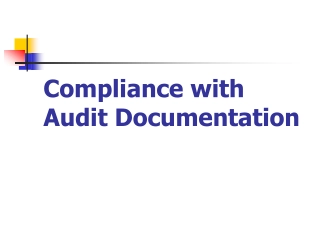
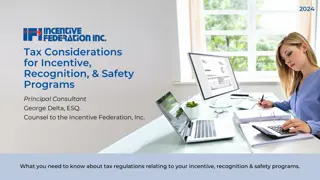
![Town of [Town Name] Real Estate Tax Rates and FY 2024 Budget Summary](/thumb/62211/town-of-town-name-real-estate-tax-rates-and-fy-2024-budget-summary.jpg)
